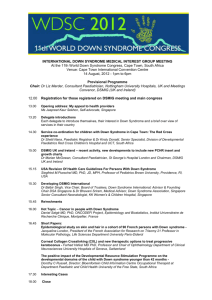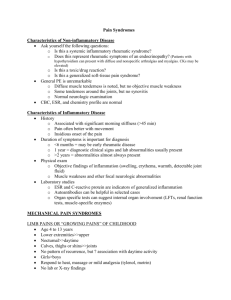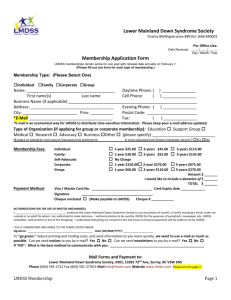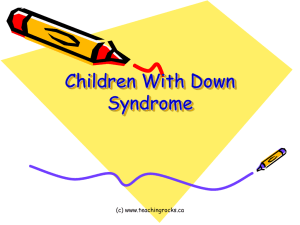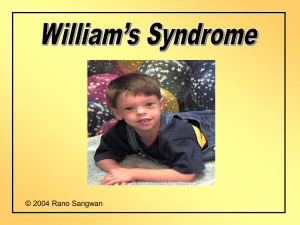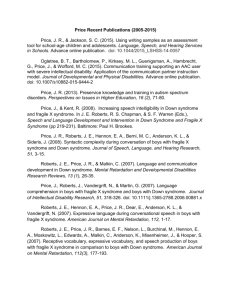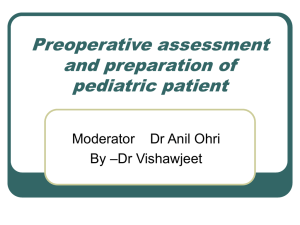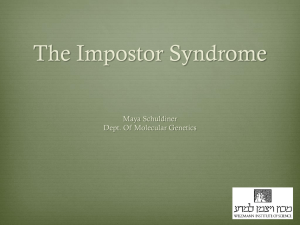Mental Retardation Traumatic Brain Injury
advertisement
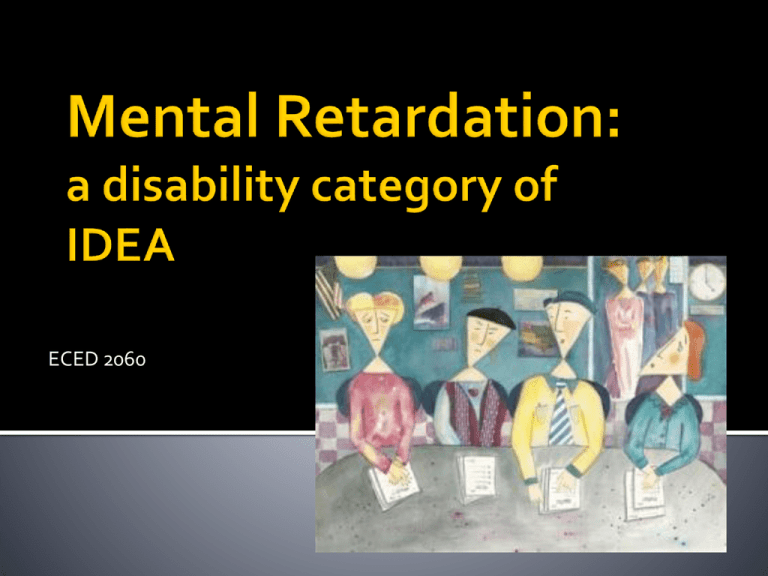
ECED 2060 IDEA: mental retardation Significantly subaverage general intellectual functioning, existing concurrently with deficits in adaptive behavior and manifested during the developmental period, that adversely affects a child’s educational performance. Reasoning Planning Problem solving Thinking abstractly Comprehension Learning Memory Generalization Motivation Academic achievement -- a collection of conceptual, social, and practical skills that have been learned by people in order to function in their everyday lives, such as reading, writing, language, money concepts, self-direction, interpersonal skills, responsibility, selfesteem, gullibility, rules, laws, victimization, eating, mobility, toileting, dressing, preparing meals, housekeeping, transportation, medications, telephone use, etc. 1. Significant subaverage intellectual functioning, as measured by standardized testing. Classified by degree of severity: mild (50 – 55 to approximately 70; moderate (35 – 40 to 50 – 55; severe 20 – 25 to 35 to 40; profound below 20 – 25. 2. Concurrent deficits in adaptive behavior (personal independence; social responsibility) 3. Age of onset during the developmental period (before 18th birthday) Individuals with mental retardation represent 1% to 3% of the general population. Mental retardation is 1.5 times more common in boys than in girls. There are more than 250 biologic causes of mental retardation, which fall neatly into these categories: Genetic; chromosomal; metabolic Perinatal or prenatal incident Acquired childhood disorders; infections; illnesses; malnutrition Environmental toxins However, only ~25% of cases fall into those biologic categories. The other ~75% have unknown causes (~30%) or are traceable to a non-biologic cause (psychosocial and sociocultural factors). 30% -- cause UNKNOWN Chromosomal abnormalities Down Syndrome -- 5 to 6% William Syndrome Fragile X Syndrome Angelman syndrome Prader-Willi syndrome Rett Syndrome Metabolism and nutritional factors Phenylketonuria Galactosemia Tay Sachs disease Hunter syndrome Hurler syndrome Sanfillipo syndrome Metachromatic leukodystrophy Adrenoleukodystrophy Lesch-Nyhan's syndrome Reye's syndrome Congenital hypothyroidism high bilirubin levels in infants hypoglycemia Infection and intoxication Fetal Alcohol Syndrome Maternal infections congenital rubella HIV Toxoplasmosis drug usage Prematurity Low Birth Weight Rh incompatibility Encephalitis Radiation Meningitis Congenital cytomegalovirus Listeriosis Methylmercury poisoning Lead poisoning Postnatal brain disease Neurofibromatosis Tuberous Sclerosis Traumas and physical accidents Asphyxiation Anoxia Seizures Intracranial hemorrhage head injury poisoning Unknown prenatal influences Anencephaly hydrocephalus Environmental Malnutrition Neglect abuse A few possible characteristics: ~Failure to meet age-appropriate expectations (norms) ~Delayed development or lack of visual or auditory response ~Delayed development or lack of language development ~Motor delays Delayed gross and fine motor coordination However, often ambulatory and capable of independent mobility, unless severe or profound mental retardation Delayed perceptual motor skills exist (e.g., body awareness, sense of touch, eye-hand coordination) Awkward or uncontrolled movement Delays or deviations in speech and language skills (mild to moderate) (Severe) significant speech and language delays and deviations (such as lack of expressive and receptive language, articulation errors, and little, if any, spontaneous interaction) (Profound) no spontaneous communication patterns, or echolalic speech, speech out of context, and purposeless speech “Special Olympics” “Kids With Down Syndrome Intro Sequence” “I Have a Voice” (See packet) (see packet) Get into groups of THREE people. Get a packet of straws and some tape. One of you cannot use your preferred hand. Another cannot use your thumbs. The other cannot talk. Make a tower of straws as high as you can. It cannot be attached to anything – it must be free-standing. The group with the tallest tower WINS!! This is just for frustration and to get a feeling of that frustration …



